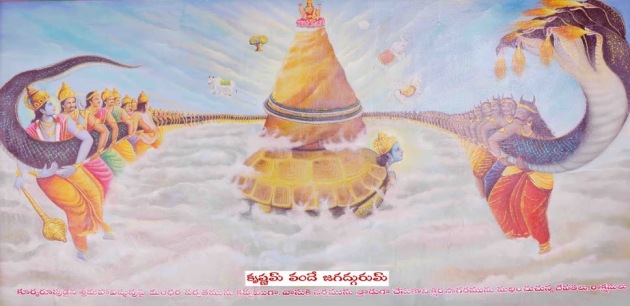This is a shrine of the Sun in a well preserved state. It is located in Srikakulam Town in Andhra Pradesh.The temple is said to be dating back to the 7th century. Legendary references give credit to Hindu Mythological Demigod Indra , as the person who constructed it. Historical references , however, point to a Kalinga king , Devendra Verma (Other Name of Indra) , to have constructed it. . It is believed that the original Temple, except the Deity, was totally destroyed by some Religious Fanatics in 16th Century. Though there are no traces of the ancestry, and the present Temple structure is made with Cement and Lime Stone , Historical evidences show that the Temple was extensively rebuilt in 1788 AD by a philanthropist , Sri Yelamanchili Pullaji Pantulu & his family. During 1980’s, The AP State Endowments department constructed the Pradakshina Mandapam (Circum Ambulance Passage) and the Surya Namaskara Mandapam etc. The Gopuram & Sanctum Sanctorum was rebuilt and refurbished by the dedicated efforts of Sri Varudu Babji of Aludu Village in 1999. The Anivetti (Front) Mandapam was built during year 2006 with major contributions from GMR Family, an Industrialist from the District.. Kesa Khandana Saala (For Head Tonsure) and Annadaana Satram (For Free Food Distribution) were added subsequently. The Temple is under the Administration of AP State Endowments Department, and the Executive Officer is the Officiating Authority.
The image of worship is a 5 ft tall idol, exquisitely carved out of a single, black finely polished Granite Stone. Sun God is depicted in a standing posture on a chariot, holding lotus buds and flanked by his three consorts namely Usha, Padmini and Chhaya. Padmapani is the name of this Sun God - Padma stands for wisdom, Usha and Chhaya stand for eternity. The name of the Chariot is “Vyjayanthi”, drawn by seven horses and “Anura” is the name of the Charioteer. The names of the Gate Keepers are “Madhara” and “ Pingala”. The divine Sages “Sanaka” and “Sanandana” are seen to be waving the Chamaras (Fans) for the comfort of the Sun God.
This “Panchaayatana” temple has the other Deities of Ambica, Vishnu, Ganapathi and Maheswara besides the main Deity, i.e., Lord Surya (Aditya). The daily rituals are performed as per “ Smaartha Aagama”. Ksheera Abhishekam is performed to the Moola Virat every month on the “sankramanam Day” , i.e, the day on which Sun transits from one Raasi (Zodiac Sign) to the other. The Temple, like most other Hindu/ Sun Temples in India, is constructed in such a way that Sun Rays fall on the Idol for a few days in every March and September months of the year.
Legend says that one day Indra, a Hindu Mythological Demigod, came to worship Lord Shiva in the ancient Uma Rudra Koteswara Swamy Temple near Srikakulam, a sub Temple of the famous Srikurmam Shrine. He came in very late and Since it was in- approppriate to seek Darshan after the closure of the Temple, he was refused to get an entry by Nandeeswara, guarding the Shiva Temple. Filled with Arrogance and being ignorant of the supreme Power of Lord Shiva, Indra began arguing with Nandeeswara for an entry , resulting in a scuffle. Angered at this, Nandeeswara picked up Indra in his horns and threw him away.
Indra fell unconscious at a distance of 2 yojanas to the east of Uma Rudra Koteswara Temple. After awakening, Indra realized the Supreme Power of Lord shiva. To get relief from his Sins, He consulted the Sages and was told about possible Planetary related Evil influences behind the Wrong doing. So, to get relieved, he prayed the Chief Planet of Nava Grahaas, The sun God – Another Hindu Mythological Demi God, for relieving him of the sins. Sun God appeared before him and advised Indra to construct a Temple for him , by digging at the place where he fell. He did the same and found an Idol of Sun God, which he installed in the Temple at Arasavalli . Later Indra performed all the Rituals related to relief from Planet related Evil Effects (Graha Shanthi) and thereafter went to the Temple of Uma Rudra Koteswara Swamy to have the Darshan of Lord Shiva and attained Peace Of Mind. This Temple is now the famous Sun God Temple at Arasavalli (Previously known as Harshavalli, meaning Pleasure) . The Pond which was formed at this area, eventually came to be known as Indra Pushkarini.
Sun is the Chief planet among the Nava Grahaas in Hindu Mythology , and his worship wards off all the Evils caused by the Planetary Movements (Graha Doshas). The Sun Worship is synonymous with the worship of Gayatri and that is why the Sages and orthodox devotees offer “Arghyam” to the Sun in the morning, noon and evening. The Worship of Sun God is believed to be relieving all the human sufferings, particularly those related to Health, like Skin Diseases, Eye Diseases, Leprosy, Digestion etc.








